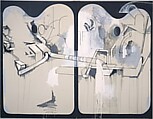Two Palettes (Sears, Roebuck; Francis Picabia)
Jim Dine American
Not on view
Pop Art originated in England in the late 1950s, but gained international notoriety when it was embraced by young American artists in the 1960s. Reacting against the extremes and excesses of Abstract Expressionism (the art movement that preceded it), they sought to reintroduce recognizable imagery into their work by conspicuously quoting from both popular and high art sources and from familiar daily objects. Although never totally comfortable with the label "Pop Artist," Jim Dine was one of the movement's leading practitioners, along with his contemporaries Roy Lichtenstein and Andy Warhol and such immediate predecessors as Jasper Johns and Robert Rauschenberg.
Dine's Two Palettes (Sears, Roebuck; Francis Picabia) exemplifies the Pop philosophy in its use of quoted imagery as well as in its various light-hearted art historical references. This mural-size diptych, painted when the artist was twenty-eight years old, is comprised of two adjoining canvases (each almost 8 by 5 feet), upon which giant palettes are silhouetted against a black background. It relates to a series of works made between 1961 and 1964 that use the palette shape both as backdrop for other imagery and as a surrogate self-portrait. Throughout his career Dine has used inanimate objects which have some personal meaning—e.g., bathrobes, ties, and building tools—to inject an autobiographical presence into his work. In this case, he has also included two faint line drawings of his prematurely bald head (most fully delineated at the bottom center of the right panel).
Dine playfully subverts the notion of the palette as the site where a painter mixes colors, rendering them not in bright hues, but in monochromatic black, white and gray. As the full title of the work suggests, he has connected two seemingly unrelated subjects: the famous Sears, Roebuck stores (known for their extensive mail-order business) and the French Dadaist Francis Picabia (whose witty satirical artwork from the early twentieth century anticipated Surrealism). Across the two halves of the composition a complex heating system of ducts and boxes is drawn (inspired by illustrations in the Sears, Roebuck catalogue). Drips of thin and thicker white paint flow like water from ends of the pipes, while darker drips cascade down the canvas surface, making gentle mockery of Abstract Expressionism's gesturalism. Dine's homage to Picabia includes copying specific mechanical shapes from the Dadaist's work and signing his initials "F.P."
Due to rights restrictions, this image cannot be enlarged, viewed at full screen, or downloaded.

